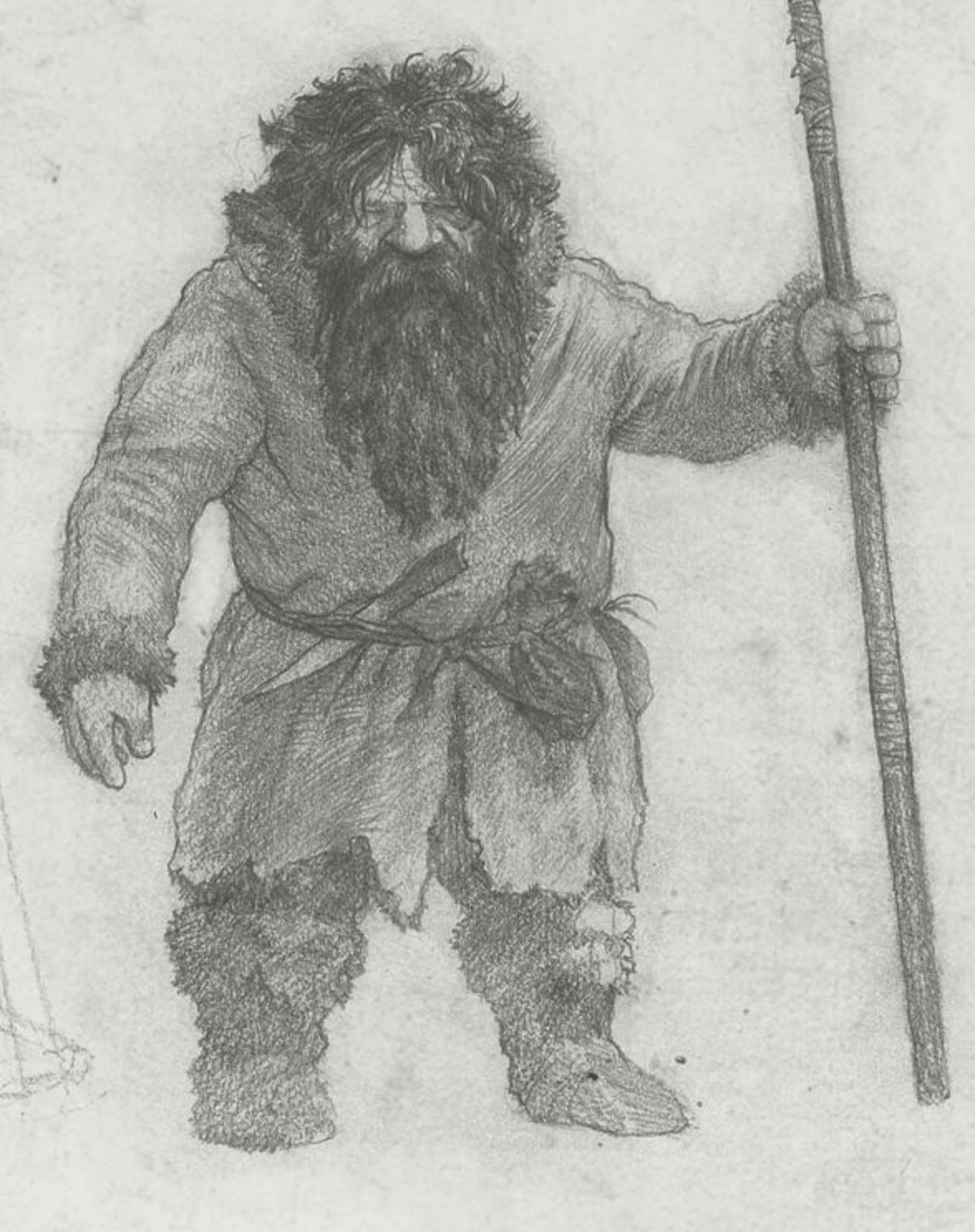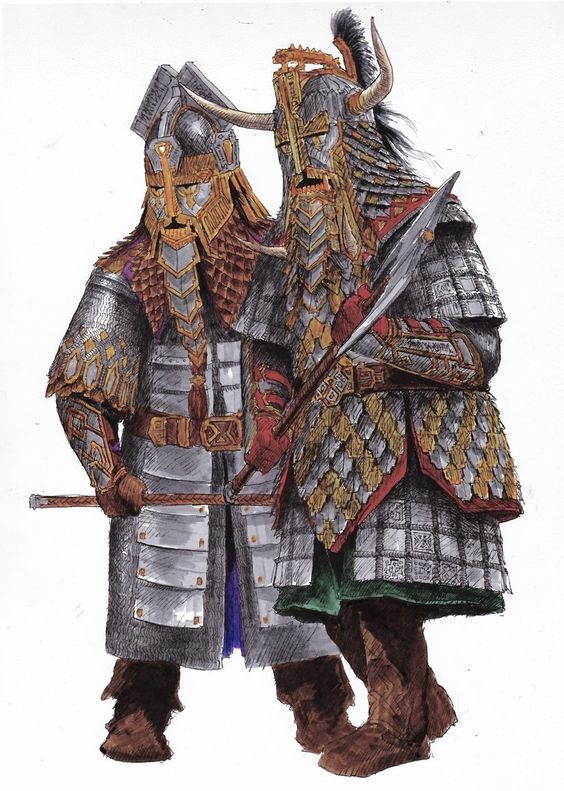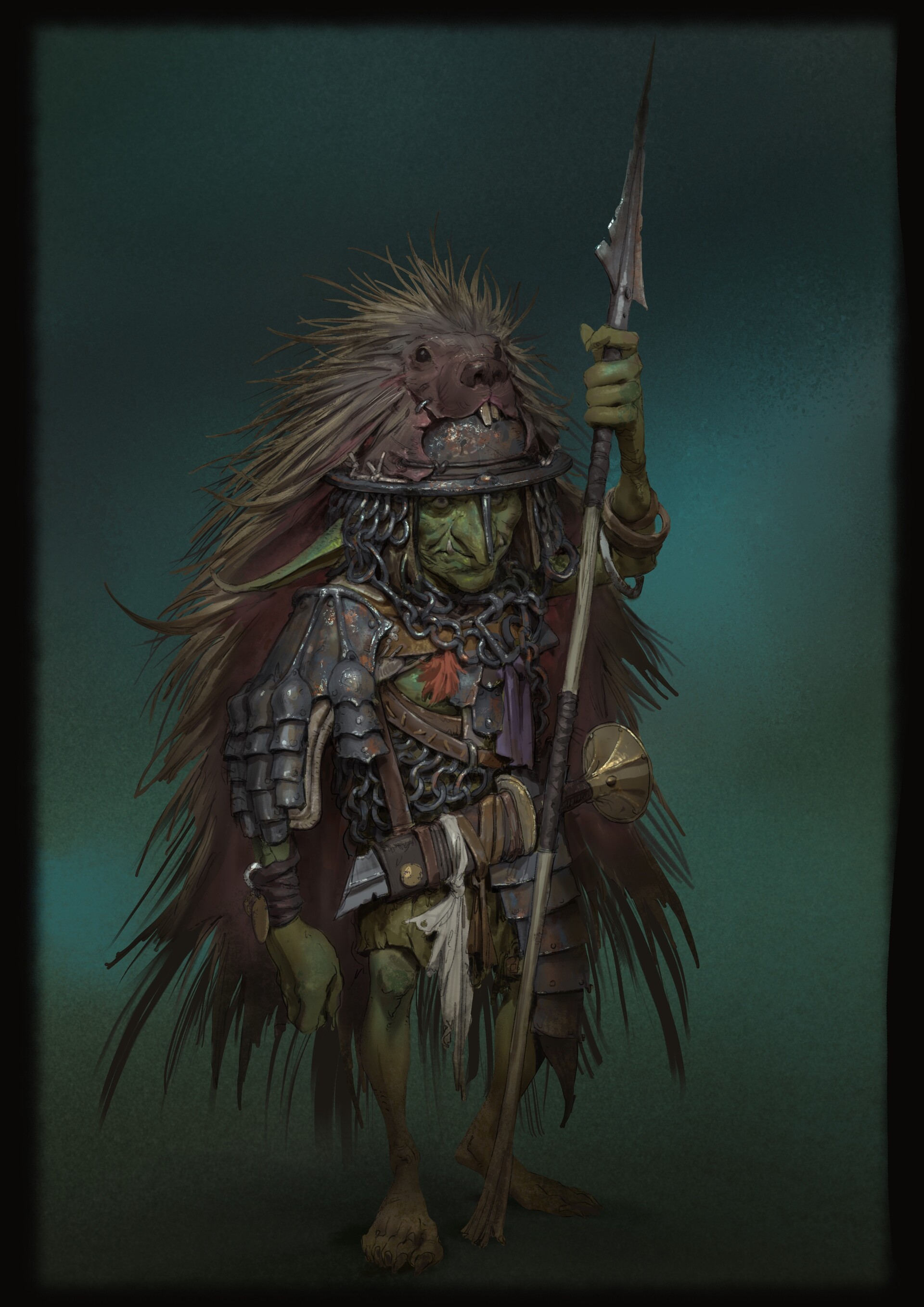The First Das EkLachen
Das EkLachen was the mighty Dwarrow kingdom that lay beneath the Mountains of Das EkLachen. A kingdom of two peoples, the EkLachen and VolKernen, Das EkLachen prospered for many millenia until its final destruction by the Chromatic Dragon Gaorung in 777 Year of Huraedon. Now it is abandoned, and filled with dangers, only visited by those young VolKernen who long to see the fair carven halls of their forefathers, going there to sing and chant their songs of longing: letting their voices and instruments ring in the vast darkness.
This article specifically deals with the First Das EkLachen, which began with High King Hincker and ended with High King Azlaghl, when Nelqora made it a vassal. It would later be reinstituted by King Bazoh in 1731 Year of Nelqora as the Second Das EkLachen—this is the one that Gaorung destroyed. The First Das EkLachen is largely remembered by the Dwarrow as a time of cultural supremacy cut short.
History
In the darkness of Arda already the Dwarves wrought great works, for even from the first days of their Fathers they had marvellous skill with metals and with stone; but in that ancient time iron and copper they loved to work, rather than silver or gold.
The crevices of the Mountains of Das EkLachen have long been populated by Dwarrow. These were the ancestors of the modern VolKernen. Most famous of these ancient cultures was the Crevice Culture—their squatting, one-eyed men can still be seen peering out of the many glens of the Mountains. Nevertheless, they were rude in material culture and had little impact on the history of that region until the arrival of the southern EkLachen in 900 Year of Nelqora.

The arrival of the EkLachen, led by King Hincker (930-1002 YoN), is as to the history of the Northern Dwarrow as the arrival of the Nelqorana is to our own race: a thunderbolt. All things were changed with their arrival. Electrified, pressed onward by the organised mind of the Dwarrow of the Das, the VolKernen grew to the fullness of their creative powers. In turn, the native VolKernen taught the EkLachen all the secrets of the hills and stones—vital to the health of a Dwarf Hall.
Together, they made the mighty Fortress of Gungrøl, built into the cliffs of Ar-ban-Ikiil. They established the White Gates of EkLachen, lacquered in Adamant, and they put strong bolts to the left and right.
They gathered all their jewelry and melted them. From the gold they made seven large goats, the Pôlii Goats, and set rubies in their eyes; their wool was spun with gold, and the hooves were of obsidian. They set the Pôlii Goats before the White Gates, lining them by the stone road, and told them: "Gnaw on those who seek to do us harm!"
From the silver they made forty crowns, in them they set twelve rubies, twelve sapphires, and thirteen diamonds. And they carved on the temples the runes 'Peace' and 'Multiplication', and into the carved runes they set mithril leaf, which for each crown numbers one root in worth. These crowns they gave to the chieftains and kings of the VolKernen and EkLachen, twenty to the Volkernen and twenty to the EkLachen.
But they made one more crown, all of mithril, and its worth is beyond valuation. And they wrote in silver on its white face the words 'Justice', 'Harmony', 'Strength', 'Joy', and 'Father'. This is the Cedarkar: the crown of the High King of Das EkLachen—which should never leave his grasp, for he is reincarnated through his last son, his heir.
They began to delve into the Mountains. There they made Halls and Mansions fairer than any city or town aboveground. In those times, the total number of Halls numbered 413, though they were categorised under Great Halls which numbered, and would always number, forty. The High King was Hincker. Peace reigned. But all was not well.
Devolution of State
The goal of the state is the temporal happiness of man.
The Dwarrow of Das EkLachen initially followed one state headed by one High King. But with the death of Hincker at the age of 730, in 1002 Year of Nelqora, there came a steady devolution of authority. Because Hincker's children were all very aged—and their children also, and their children's children—there was a period in Das EkLachen's history where there was a new High King every decade. This destabilized the kingdom; and with the assassination of the High King Hincker IX, and the subsequent end of the clan Veki, the treaty of the First Hall was signed in 1094 Year of Nelqora, partitioning Das EkLachen into three kingdoms in coalition with each other: Das Lufdh, Das Ezuilik, and Das Tae-dad. The Cedarkar was placed in an iron safe, waiting for its rightful heir to take it up and unite the kingdoms.

The following years were ones of tumult. The kingdoms, mostly disregarding their status as allies, would feud and bicker with each other. The various lords of these kingdoms would lead their respective Halls into petty conflicts with another lord, seeking the access to mines, farms, and plunder that they believed was wrongfully withheld from them.
The reign of King Gebev (1098-1267) of Das Lufdh is of note in the history of Das EkLachen; in the one because of his solemn adhesion to the unity of Das EkLachen; in the other because he was the first king of the partitioned states to take a stand as a champion of law and public order against the feudal system which was now arising.
With his minister and friend, Onuvin VI, he developed and realized the ideal of kingly duty. He established a great Commune in which the mighty Hall Lords under his rule were to convene every six months. And he ensured their continued subservience by their travel to and extended stays in his Mansion. By a series of cunning weddings, the most important being his marriage to Peledine of the Eighty-first Hall by which he got an alliance with the Kingdom of Das Ezuilik, King Gebev built a base of power around himself. And his redistributionist policies were so beloved that the station of the king began to take on a moral force, and set the grounds for the establishment of the Royal Cult.
King Gebev died at the age of 437, slain in a war to subjugate the Lord Soiro-ahlk of the Fifty-eighth Hall. He was succeeded by Azlaghl, named after the King of the Whole Underworld of legend, and it was he that would go on to make the northern Dwarrow of the Das the mightiest power of the Mountains.
Azlaghl's Reign
The emperor is confident and joyful.
King Gebev hadn't idled in matters of war. He was fortunate that his kingdom had lain above a hitherto untapped source of iron. So he made a mighty armament, superior to all the other kingdoms. When Azlaghl (1268-1311) was crowned he immediately began his conquests.
Das Ezuilik and Tae-dad were too disorganized to defend against him, and their lords bickered amongst themselves even as Azlaghl sieged their gates. But Azlaghl's own nobility were all chained by his father's diplomacy; cowed, they sent their levies and fought for him with earnestness and total obedience. Only at the end, at the bloody Coalition Battle of Natûvoris (1281 YoN) was there a chance for Azlaghl to lose it all.

But by 1282 Year of Nelqora he chanted to the Bearded Falls of Nin-bak-Tûl his songs of victory, and the Hosts of Das Lufdh marched on all the highways of the underworld of EkLachen, unhindered, glorying in their successful unification of all the VolKernen and EkLachen.
The ministers of the Cedarkar crown saw in Azlaghl the resemblance of old High King Hincker, and deigned him a true reincarnation. Azlaghl was crowned High King in 1284 Year of Nelqora, and began to aggressively expand his dominions both under and aboveground. He established the first colonies on the overland, and quickly expanded them.
It was at this time that the EkLachen Public Tongue became widespread across the overland, and became the Common Tongue of communication for the peoples of the eastern Mountains. Of all speech Io EkLachen was the most charming, and all good poetry and literature were written in that language. The Charitable Berserker became a popular character, the Scratch-Drum became the favored instrument, and EkLachen Form became the preferred form of poetry. EkLachen architecture, known for its granular carvings and high arches, also became increasingly popular among the wealthy Human kings.
Massive amounts of resources came pouring into Das EkLachen, both from trade and their aboveground colonies, and Das EkLachen entered into a golden age. High King Azlaghl, at the peak of his prosperity, established the Royal Cult (1299 YoN). The High King was exalted into shadowy magnanimity. Never present among his people, the High King was reclused with his harem and dealt with matters only from his Imperial Palace, which was built in the Third Hall. The highways leading there were broken, except for the one heading from the First Hall.
Azlaghl wished to establish a powerful bureaucracy in which the nobility was impotent and the skilled duly rewarded. He believed that having the position of High King be transformed into one of an unseen, terrifying presence was a requisite for the establishment of this bureaucracy, which would work like a machine, each cog doing its specific function, and even if there was a hiccup no single gear would be powerful enough to destroy the whole machine.
Unfortunantly, while the position of High King would long remain darkened by mysticism and exaltation, Azlaghl would not have the time to build the bureaucracy of which he'd dreamed.
This golden age would not last long. For Azrübel had landed ashore at Lubim's Edge with 10,000 Nelqorana (in 1301 YoN), and he sought the conquest of all the Northern Mountains.
The Third Invasion of the North
". . . and then, Solon, your country shone forth, in the excellence of her virtue and strength, among all mankind."
Azlagh's reign was not without internal strife. There was a loud minority of isolationists: persons who believed that expanding beyond the White Gates would lead to destruction. There were also the many hives of Orcs and Goblins that crisscrossed the deepest—and most important—mines of Das EkLachen. Much of High King Azlaghl's energy was spent fighting the wants of the isolationists and battling the Orcs and Goblins.
In November 30th, 1300 Year of Nelqora, a raid of Goblins into the Thirty-first Hall led to the death of three dozen Dwarrow. Prince Ezun, sixth in line to the throne, was given command over a committee to oversee solutions to the raids but would prove ineffective in stopping the raids. The Orcs and Goblins would become increasingly aggressive; eventually, they enacted large invasions.
Many of the lowest Halls and lowest mines were conquered—cutting off the Dwarrow from their richest mithril veins. The Dwarrow of EkLachen wouldn't reconquer those Halls until nearly 400 years had passed.
As Azrübel conquered farther inland, even razing Little Taurtauc, Azlaghl began to conduct diplomacy with the Nelqorana. For a long while, his policy was to maintain his borders without much intervention in the outer world but to not retreat behind the White Gates. In this way, he thought, he could maintain a balance between the powerful parties vying for either isolationism and expansionism. But when the Nelqorana showed they would become an increasingly dangerous invasion force, Azlaghl began to consider his defenses.
Azlaghl began the construction of high walls around exposed areas of his border. He built mighty sea forts, established the Goat Scouts, updated the defenses of the Fortress of Gungrøl, prepared demolitions of important highways and entrances into the Halls of EkLachen, and began to store up provisions for an extended battle. But poor Azlaghl suffered many heavy blows. Five of his sons were suddenly struck, one after the other, with a deadly fever and died. Regarding his new heir, Ezun, Azlaghl bemoaned:
"Kings should have long arms, to repress with all their might, according to their office, the daring of those who would rend the State by war. But never before have I seen a boy with stubbier appendages!

In 1310 Year of Nelqora, Azrübel came to the White Gates and demanded Azlaghl to submit to vassaldom. When the High King refused, the Nelqorana left without much fuss.
But news spread throughout the Halls like electricity: Ezun had been kidnapped! A graver insult could not be offered to the Dwarrow and, indeed, a scarcely less terrifying one. The death of any heir of the High King was considered a tragedy of monumental import; the death of an heir by those who would not bury him properly, and so ensure his continued reincarnation, was unthinkable. Azlaghl was pressured to personally deal with the matter, to leave the safety of his palace. So he began to prepare a great store of tribute to personally buy back his son. They agreed to meet their embassies on the island of Das Itchi, called by the Nelqorana Nova Concord.
Having little faith in the Nelqorana, Azlaghl brought with him many Hosts. They were fearsome to look on. The warriors of Das EkLachen were grim-faced and wore beast-masks with curved fangs. They carried in their fists long spears, and on their belts were iron axes. In the sun their white shields and grey armors gleamed as if flaming, and none could count the number of their banners. The High King set out on a fleet of such number and majesty that the Dwarrow shall never see again. The fleet of Azlaghl darkened the sea upon the north of the land, and it was like an archipelago of a thousand isles. And when he landed ashore he saw that both embassies brought more force than was agreed.
Though Azrübel brought more.
So began the battle of Nova Concord. And here Azlaghl discovered the skill of the mariners of Nelqora, and he discovered firsthand how deadly their ships could be. For they came secretly from the east with a great wind, invisible with the pale sun behind their white hulls. And they came suddenly, rushing, striking as thunderbolts. They loosed many beads of ice-fire upon the heavy Dwarrow crafts. The cold that burned like fire terrified the EkLachen, and many leaped from their ships and were drowned by their heavy armors. The sea-battle quickly turned against Azlaghl.
On the island, Azlaghl had brought with him a larger contingent than Azrübel had, but this availed him not. Azrübel came like a storm upon the High King's guard. The thrusting of his spear caught Azlaghl's head and burst it, leaving not even a scrap for the Dwarrow to recognize. With the death of the High King, the Dwarrow broke and were all killed in the rout.
The Nelqorana returned with Prince Ezun and had him crowned High King. Then, Ezun declared the vassalship of Das EkLachen to Nelqora. In their joy of victory, the Nelqorana left the Palace of the King and ransacked all the Halls they passed through. Heavy laden with treasure, they went to the Gates and hewed them down, and scraped it of its Adamant gilding. They took with them the Pôlii Goats, and thirteen of the Silver Crowns. Many of the VolKernen still spit on the name of Nelqora.
Ezun (1312-1523) ruled peacefully afterward, though later he was assassinated and his young brother took the throne. Many Dwarrow despise him for working with the Nelqorana.
His reign marked the end of the First Das EkLachen, peace be unto its memory.
EkLachen, de Das!
EkLachen, we stand allied!

930 Year of Nelqora - 1311 Year of Nelqora
- The Kingdom of EkLachen
- The VolKernen Kingdom
- The Northern Das
- Hincker (930-1002 YoN)
- Hincker II (1003-1011 YoN)
- Hincker III (1012-1019)
- Hincker IV (1020-1033)
- Hincker V (1034-1046)
- Hincker VI (1047-1055)
- Hincker VII (1056-1072)
- Hincker VIII (1073-1089)
- Hincker IX (1090-1094)
- Azlaghl (1268-1311 YoN)







This was great. There were some concepts that I would not get at first glance but it read so much like poetry, that I didn't mind.
Thank you. I'm especially glad you liked the prose.